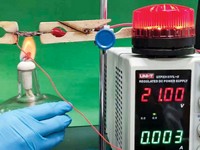Advertisement
Grab your lab coat. Let's get started
Welcome!
Welcome!
Create an account below to get 6 C&EN articles per month, receive newsletters and more - all free.
It seems this is your first time logging in online. Please enter the following information to continue.
As an ACS member you automatically get access to this site. All we need is few more details to create your reading experience.
Not you? Sign in with a different account.
Not you? Sign in with a different account.
ERROR 1
ERROR 1
ERROR 2
ERROR 2
ERROR 2
ERROR 2
ERROR 2
Password and Confirm password must match.
If you have an ACS member number, please enter it here so we can link this account to your membership. (optional)
ERROR 2
ACS values your privacy. By submitting your information, you are gaining access to C&EN and subscribing to our weekly newsletter. We use the information you provide to make your reading experience better, and we will never sell your data to third party members.
Materials
Fire alarm wallpaper
Graphene oxide-based sensor attached to flame-resistant wallpaper sets off an alarm at high temperature
by Bethany Halford
March 19, 2018
| A version of this story appeared in
Volume 96, Issue 12
Merging interior design and safety, scientists in China have developed a fire-resistant wallpaper equipped with an alarm. Two types of nanomaterials were key to making the danger-detecting decor. Glass fibers wrapped with ultralong hydroxyapatite nanowires were woven into an inorganic, fire-resistant paper. This paper was then attached to a sensor made from polydopamine-modified graphene oxide that responds to high temperatures (ACS Nano 2018, DOI: 10.1021/acsnano.8b00047). The wallpaper was developed by researchers at the Shanghai Institute of Ceramics and the University of Chinese Academy of Sciences led by Ying-Jie Zhu. Although hydroxyapatite—a form of calcium phosphate found in teeth and bone—is typically brittle, it becomes flexible when fashioned into ultralong nanowires. Paper made from glass fibers wrapped with these hydroxyapatite nanowires is environmentally benign and can be colored with dyes or with a printer. An attached graphene oxide sensor that’s connected to an alarm and a warning light switches on when the high temperatures that accompany a fire convert graphene oxide from an insulator into a good conductor of electricity. Modifying the surface of graphene oxide with polydopamine helps accelerate this transition and helps the graphene oxide resist flames. Hydroxyapatite nanowire paper equipped with this type of sensor was able to sound an alarm for more than five minutes in a direct flame, demonstrating that the electronics remained intact.





Join the conversation
Contact the reporter
Submit a Letter to the Editor for publication
Engage with us on Twitter